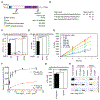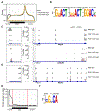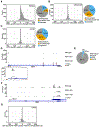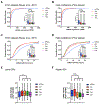Identification of the m6Am Methyltransferase PCIF1 Reveals the Location and Functions of m6Am in the Transcriptome
- PMID: 31279658
- PMCID: PMC6703822
- DOI: 10.1016/j.molcel.2019.06.006
Identification of the m6Am Methyltransferase PCIF1 Reveals the Location and Functions of m6Am in the Transcriptome
Abstract
mRNAs are regulated by nucleotide modifications that influence their cellular fate. Two of the most abundant modified nucleotides are N6-methyladenosine (m6A), found within mRNAs, and N6,2'-O-dimethyladenosine (m6Am), which is found at the first transcribed nucleotide. Distinguishing these modifications in mapping studies has been difficult. Here, we identify and biochemically characterize PCIF1, the methyltransferase that generates m6Am. We find that PCIF1 binds and is dependent on the m7G cap. By depleting PCIF1, we generated transcriptome-wide maps that distinguish m6Am and m6A. We find that m6A and m6Am misannotations arise from mRNA isoforms with alternative transcription start sites (TSSs). These isoforms contain m6Am that maps to "internal" sites, increasing the likelihood of misannotation. We find that depleting PCIF1 does not substantially affect mRNA translation but is associated with reduced stability of a subset of m6Am-annotated mRNAs. The discovery of PCIF1 and our accurate mapping technique will facilitate future studies to characterize m6Am's function.
Keywords: PCIF1; m(6)A; m(6)Am; mRNA methylation; mRNA stability; mRNA translation.
Copyright © 2019 Elsevier Inc. All rights reserved.
Conflict of interest statement
DECLARATION OF INTERESTS
S.R.J. is scientific founder, advisor to, and owns equity in Gotham Therapeutics.
Figures





Similar articles
-
PCIF1 Catalyzes m6Am mRNA Methylation to Regulate Gene Expression.Mol Cell. 2019 Aug 8;75(3):620-630.e9. doi: 10.1016/j.molcel.2019.05.030. Epub 2019 Jul 3. Mol Cell. 2019. PMID: 31279659 Free PMC article.
-
HIV reprograms host m6Am RNA methylome by viral Vpr protein-mediated degradation of PCIF1.Nat Commun. 2021 Sep 20;12(1):5543. doi: 10.1038/s41467-021-25683-4. Nat Commun. 2021. PMID: 34545078 Free PMC article.
-
The Mammalian Cap-Specific m6Am RNA Methyltransferase PCIF1 Regulates Transcript Levels in Mouse Tissues.Cell Rep. 2020 Aug 18;32(7):108038. doi: 10.1016/j.celrep.2020.108038. Cell Rep. 2020. PMID: 32814042
-
PCIF1, the only methyltransferase of N6,2-O-dimethyladenosine.Cancer Cell Int. 2023 Oct 1;23(1):226. doi: 10.1186/s12935-023-03066-7. Cancer Cell Int. 2023. PMID: 37779183 Free PMC article. Review.
-
Discovering and Mapping the Modified Nucleotides That Comprise the Epitranscriptome of mRNA.Cold Spring Harb Perspect Biol. 2019 Jun 3;11(6):a032201. doi: 10.1101/cshperspect.a032201. Cold Spring Harb Perspect Biol. 2019. PMID: 31160350 Free PMC article. Review.
Cited by
-
Novel Roles of RNA m6A Methylation Regulators in the Occurrence of Alzheimer's Disease and the Subtype Classification.Int J Mol Sci. 2022 Sep 15;23(18):10766. doi: 10.3390/ijms231810766. Int J Mol Sci. 2022. PMID: 36142676 Free PMC article.
-
Photoactivatable mRNA 5' Cap Analogs for RNA-Protein Crosslinking.Adv Sci (Weinh). 2024 Sep;11(36):e2400994. doi: 10.1002/advs.202400994. Epub 2024 Jul 24. Adv Sci (Weinh). 2024. PMID: 39049186 Free PMC article.
-
The crosstalk between m6A RNA methylation and other epigenetic regulators: a novel perspective in epigenetic remodeling.Theranostics. 2021 Mar 4;11(9):4549-4566. doi: 10.7150/thno.54967. eCollection 2021. Theranostics. 2021. PMID: 33754077 Free PMC article. Review.
-
In Vitro Transcribed RNA-based Luciferase Reporter Assay to Study Translation Regulation in Poxvirus-infected Cells.J Vis Exp. 2019 May 1;(147):10.3791/59626. doi: 10.3791/59626. J Vis Exp. 2019. PMID: 31107441 Free PMC article.
-
A Pan-Cancer Analysis of the Oncogenic and Immunogenic Role of m6Am Methyltransferase PCIF1.Front Oncol. 2021 Nov 23;11:753393. doi: 10.3389/fonc.2021.753393. eCollection 2021. Front Oncol. 2021. PMID: 34888238 Free PMC article.
References
-
- Barral K, Sallamand C, Petzold C, Coutard B, Collet A, Thillier Y, Zimmermann J, Vasseur JJ, Canard B, Rohayem J, et al. (2013). Development of specific dengue virus 2′-O- and N7-methyltransferase assays for antiviral drug screening. Antiviral Res 99, 292–300. - PubMed
Publication types
MeSH terms
Substances
Grants and funding
LinkOut - more resources
Full Text Sources
Other Literature Sources
Molecular Biology Databases
Research Materials
Miscellaneous

